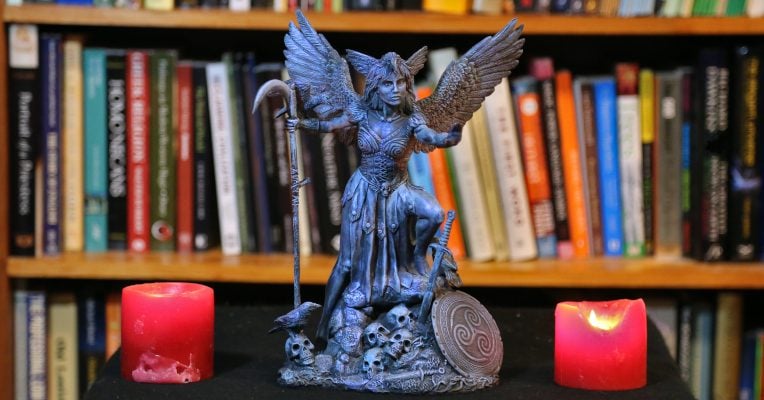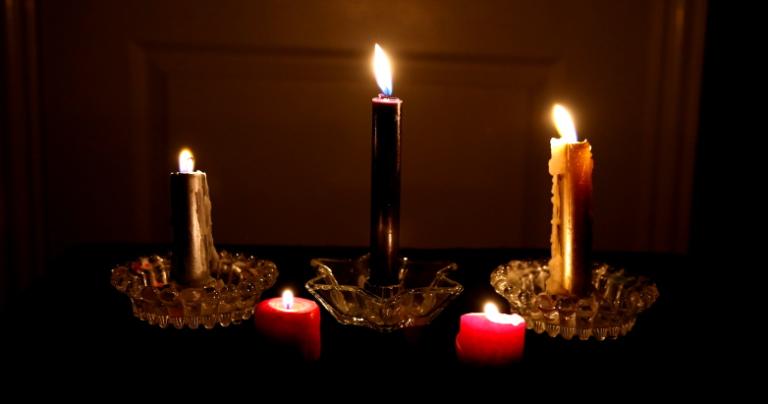In this post we address four questions on three topics, beginning with the question of art in Paganism.
The role of art in Paganism
What’s the role, responsibility, or purpose of art in a Pagan or polytheist path?
The short answer is “the same as in any other religious tradition.” But I imagine most people don’t have a very good answer to that question either, so let’s dive into it.
First and foremost, art exists for its own sake. Why did people 30,000 years ago crawl deep into caves and paint on the walls, working by torchlight? Why do people today write stories and create songs knowing full well few will read or hear them, much less buy them?
Why do people climb mountains?
Because we’re human and this is what we do. Art – in all its many forms – needs no additional purpose.
Still, there are benefits to Pagan art, and those benefits can be considered a purpose.
1. To honor the Gods and ancestors. Look no further than the new Morrigan statue by Joe Laudati. It was created because Joe and the folks at The Awareness Shop kept getting requests for a Morrigan statue to use in worship and devotion. Good artwork helps us focus our attention on what – and Who – we want to connect to and honor.
2. To create a record. One of the reasons I take pictures at rituals is to document our rites: to show others what we and how we do it.
3. To communicate values. No one paints a picture of something they don’t care about. Whether our art praises something or criticizes it, it makes a statement. It tells us what is good and what is bad, what is eternal and what needs to change.
4. To inspire others. Good art stirs emotions. Good art motivates people to get up and do something. Make good art.
Restarting a spiritual practice
How do you get back to observance and get back into the headspace to connect with deity? I used to have morning and evening rituals many years ago, and I kept my altar up at all times. I know that I felt it helped me balance better with life in general when I did that. I am having a hard time getting my feet under me to do that again, but I want to.
Last year I wrote Rebooting Stale Devotion. It has some specific ideas that may be helpful here. But here I want to address the question of how to “get back into the proper headspace,” which I interpret as finding the motivation and desire to do something you know you need to do but have gotten out of the habit of doing.
First, realize that getting out of practice is OK. It’s not desirable, but it happens. It happens to most of us sooner or later.
Many of us grew up in shame-based religions that tell us we’re bad people because we aren’t perfect. This is simply not true. We’re not perfect because we’re human, and humans are inherently flawed.
Shame often means that it’s easier to continue not doing our practice and pretending it’s no big deal or that we just can’t do it today than to admit we’ve let things go. This isn’t helpful.
Just start.
You’ve had a practice before. You know what works for you and what doesn’t. Pick one thing and do it.
You need not begin with an apology or with special offerings or with asking for forgiveness (unless you broke an oath, but that’s another topic for another time).
Just start.
“Headspace” is dependent on how you feel, and you can’t control how you feel. You can control how you act, and how you act influences how you feel. Start with one thing and do it consistently for a week. Then add another thing. How you feel about it isn’t important. What’s important is that you do it.
Just start.
Over time, you’ll find those connections rebuilding and restoring. You’ll find your headspace returning. You’ll remember the benefits of regular spiritual practice, because you’ll experience them.
Just start today.
Interfaith work for Pagans
Neil Pitchford asks:
What areas of commonality would you emphasize when in discussions within an interfaith setting?
And an anonymous reader asks:
How can Pagans, as diverse as we are, be interfaith leaders, community leaders, and represent Paganism in the public eye?
Interfaith work often begins with the simple goal of dialogue: if we sit down together, eat together, and talk together, we’ll get to know each other as people and we’ll learn to respect each other. In practice that’s rarely enough, and dialogue often degenerates into persuasion. Conservative religions are notorious for using interfaith forums to proselytize or otherwise proclaim the superiority of their path.
As the header of this blog says, I’m a Pagan, a Druid, and a Unitarian Universalist. When I walk into a UU Sunday service, I know that the majority of the people in the room don’t share my beliefs. But they share my values. UUs express these shared values in Seven Principles.
When Pagans gather with progressive Christians, Reform Jews, most Buddhists, and other people of good will, there are some values we usually share: a respect for Nature and a concern for the environment, compassion in human relations – especially in regard to refugees and the poor, and a commitment to religious freedom. Not the kind of “freedom” that allows the majority (or an especially vocal minority) to impose its beliefs and morals on everyone else, but the tolerance and acceptance of all religious paths (at least those that don’t fall into the “imposing their beliefs on everyone else” category – the Paradox of Tolerance is real).
If our commitment to our shared values is genuine, then real interfaith cooperation can happen. That’s the key to the second question. If we approach interfaith work with the idea of educating everyone about Paganism, we’re likely to fail. But if we come to interfaith work because we want to contribute to the greater cause of justice and freedom, we’re likely to succeed – and we’ll teach people a few things about Paganism in the process.



















